
|
Now it is not observable. It will appear in the morning sky again at 13-14 mag in August.
Date(TT) R.A. (2000) Decl. Delta r Elong. m1 Best Time(A, h)
Apr. 27 3 2.32 15 30.5 3.000 2.024 11 12.5 18:47 (102,-10)
May 4 3 19.24 16 26.7 3.020 2.030 8 12.6 18:41 (103,-11)
|

|
It approached to Earth down to 0.3 a.u. in mid February, and brightened up to 5.5 mag (Feb. 13, Juan Jose Gonzalez). Now it is fading. But it is still bright as 11.7 mag (Apr. 21, Thomas Lehmann). In the Southern Hemisphere, it is not observable now. It will be unobservable soon also in the Northern Hemisphere.
Date(TT) R.A. (2000) Decl. Delta r Elong. m1 Best Time(A, h)
Apr. 27 4 25.90 33 34.6 2.445 1.730 35 12.5 18:47 (128, -5)
May 4 4 27.62 33 45.9 2.600 1.797 29 12.9 18:41 (126, -8)
|

|
It brightened up to 7.7 mag in June in 2018 (June 19, Juan Jose Gonzalez). Now it is fading. But it is still bright as 12.8 mag (Apr. 7, Chris Wyatt). In the Southern Hemisphere, it stays observable in good condition for a long time until the comet will fade out. In the Northern Hemisphere, it is not observable for a long time until autumn when the comet fades out down to 16 mag.
Date(TT) R.A. (2000) Decl. Delta r Elong. m1 Best Time(A, h)
Apr. 27 5 4.24 -40 25.5 3.883 3.605 66 12.7 18:47 ( 65, 43)
May 4 5 12.97 -38 33.3 3.975 3.660 64 12.8 18:41 ( 66, 40)
|
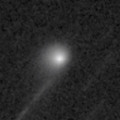
|
Now it is not observable. It will appear in the morning sky in mid May in the Southern Hemisphere, or in late June in the Northern Hemisphere.
Date(TT) R.A. (2000) Decl. Delta r Elong. m1 Best Time(A, h)
Apr. 27 1 52.54 -5 19.6 4.588 3.657 19 12.9 5:07 (278, -3)
May 4 1 57.53 -3 49.6 4.535 3.623 22 12.9 5:12 (273, 2)
|
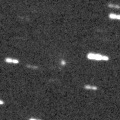
|
Now it is bright as 13.5 mag (Apr. 16, Thomas Lehmann). It stays 13 mag for a long time in 2019. In the Southern Hemisphere, it is observable in excellent condition. In the Northern Hemisphere, it is not observasble until summer in 2020.
Date(TT) R.A. (2000) Decl. Delta r Elong. m1 Best Time(A, h)
Apr. 27 7 31.69 -55 21.6 2.841 3.097 95 13.1 18:47 ( 32, 64)
May 4 7 27.48 -54 26.0 2.872 3.083 92 13.1 18:41 ( 38, 61)
|

|
Now it is 12.6 mag (Apr. 12, Ken Harikae). It stays 13-14 mag until summer. It is observable in excellent condition in the Southern Hemisphere. In the Northern Hemisphere, it will be getting lower gradually, and it will be unobservable in July.
Date(TT) R.A. (2000) Decl. Delta r Elong. m1 Best Time(A, h)
Apr. 27 16 40.69 -35 47.8 2.546 3.385 140 13.3 2:24 ( 0, 89)
May 4 16 24.95 -37 40.9 2.504 3.404 148 13.3 1:41 ( 0, 87)
|
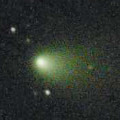
|
Now it is 12.8 mag (Apr. 7, Chris Wyatt). It is observable in excellent condition in the Northern Hemisphere. It locates somewhat low in the Southern Hemisphere.
Date(TT) R.A. (2000) Decl. Delta r Elong. m1 Best Time(A, h)
Apr. 27 11 1.96 23 46.6 1.541 2.219 119 13.7 20:42 (180, 31)
May 4 11 4.66 22 3.7 1.618 2.235 114 13.9 20:17 (180, 33)
|

|
It is not observable now. It will appear in the morning sky in May.
Date(TT) R.A. (2000) Decl. Delta r Elong. m1 Best Time(A, h)
Apr. 27 0 19.92 9 4.8 6.630 5.767 28 13.8 5:07 (253, 8)
May 4 0 24.75 9 42.3 6.576 5.767 34 13.8 5:12 (248, 13)
|
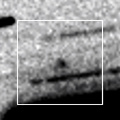
|
It will brighten up to 14 mag from May to June. However, it locates very low in the Northern Hemisphere, and it is not observable in the Southern Hemisphere.
Date(TT) R.A. (2000) Decl. Delta r Elong. m1 Best Time(A, h)
Apr. 27 0 34.55 47 33.5 2.049 1.431 39 14.6 5:07 (224,-18)
May 4 1 10.14 51 52.5 1.992 1.390 40 14.4 5:12 (220,-20)
|

|
Now it is 13.6 mag (Feb. 27, S. Szabo). It is expected to brighten up to 7 mag in 2020. Now it is not observable. It will appear in the morning sky in July.
Date(TT) R.A. (2000) Decl. Delta r Elong. m1 Best Time(A, h)
Apr. 27 3 31.66 8 36.8 5.567 4.629 19 14.5 18:47 (101, 0)
May 4 3 36.83 9 25.3 5.533 4.565 14 14.5 18:41 ( 99, -4)
|

|
It stays 15 mag from 2018 to 2019, and it will be observable for a long time in the Southern Hemisphere. In the Northern Hemisphere, it will never be observable again. It has not been observed since last October.
Date(TT) R.A. (2000) Decl. Delta r Elong. m1 Best Time(A, h)
Apr. 27 23 49.70 -47 30.5 4.232 3.988 69 14.8 5:07 (306, 40)
May 4 23 57.34 -46 51.2 4.181 3.999 72 14.8 5:12 (304, 44)
|

|
Now it is 14.2 mag (Apr. 7, Chris Wyatt). It will be fading after this. In the Southern Hemisphere, it stays observable for a long time until it fades out. In the Northern Hemisphere, it will not be observable after this.
Date(TT) R.A. (2000) Decl. Delta r Elong. m1 Best Time(A, h)
Apr. 27 5 39.59 -19 42.6 4.313 3.912 60 15.0 18:47 ( 94, 42)
May 4 5 42.45 -19 44.9 4.422 3.960 56 15.1 18:41 ( 92, 38)
|
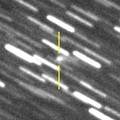
|
Now it is 15.3 mag (Apr. 6, Toshihiko Ikemura, Hirohisa Sato). It will brighten up to 15 mag from May to June, and it will be observable in good condition.
Date(TT) R.A. (2000) Decl. Delta r Elong. m1 Best Time(A, h)
Apr. 27 21 24.45 14 55.4 1.618 1.590 70 15.1 5:07 (215, 33)
May 4 21 44.18 18 36.7 1.595 1.580 70 15.0 5:12 (210, 31)
|
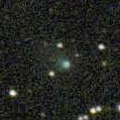
|
It is expected to brighten up to 10 mag in autumn. Now it is 15.3 mag (Apr. 21, Thomas Lehmann). In the Northern Hemisphere, it stays observable for a long time while the comet is brightening. In the Southern Hemisphere, it it not observable until mid September.
Date(TT) R.A. (2000) Decl. Delta r Elong. m1 Best Time(A, h)
Apr. 27 3 30.82 71 40.5 2.653 2.305 59 15.2 18:47 (159,-31)
May 4 3 39.20 69 51.5 2.661 2.238 54 15.1 18:41 (156,-32)
|

|
Now it is 14.6 mag (Apr. 7, Thomas Lehmann). It will be fading slowly after this. It is observable in good condition in the Northern Hemisphere. In the Southern Hemisphere, it stays extremely low for a while.
Date(TT) R.A. (2000) Decl. Delta r Elong. m1 Best Time(A, h)
Apr. 27 15 29.21 48 14.1 3.855 4.391 116 15.2 1:12 (180, 7)
May 4 15 21.82 47 53.2 3.910 4.442 115 15.2 0:37 (180, 7)
|

|
Now it is 15.2 mag (Apr. 2, Toshihiko Ikemura, Hirohisa Sato). It will be fading slowly after this. It is observable in excellent condition until spring in the Northern Hemispehre. In the Southern Hemisphere, it will be hardly observable after this.
Date(TT) R.A. (2000) Decl. Delta r Elong. m1 Best Time(A, h)
Apr. 27 8 48.55 38 32.7 5.204 5.264 87 15.5 18:47 (176, 16)
May 4 8 46.20 37 40.0 5.363 5.304 81 15.6 18:41 (171, 17)
|
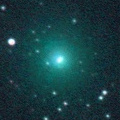
|
Now it is 14.4 mag (Apr. 2, Ken Harikae). It stayed at 10-12 mag from autum to winter. But it is fading now. In the Northern Hemisphere, it stays observable for a long time until it fades out. But it stays extremely low. It will never be observable again in the Southern Hemisphere.
Date(TT) R.A. (2000) Decl. Delta r Elong. m1 Best Time(A, h)
Apr. 27 1 5.27 46 4.9 3.254 2.506 35 15.5 5:07 (228,-21)
May 4 1 22.78 46 35.3 3.327 2.567 34 15.8 5:12 (226,-19)
|
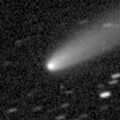
|
It brightened up to 13.2 mag from December to March (Dec. 30, Chris Wyatt). Now it is fading. It has already faded down to 15.2 mag (Apr. 22, Thomas Lehmann). It will be fainter than 18 mag in June.
Date(TT) R.A. (2000) Decl. Delta r Elong. m1 Best Time(A, h)
Apr. 27 11 22.77 -2 24.1 1.231 2.075 135 15.7 21:03 (180, 57)
May 4 11 25.90 -2 20.3 1.320 2.113 129 16.0 20:38 (180, 57)
|

|
It approached to Earth down to 0.08 a.u. in mid December, and it brightened up to 3.4 mag (Dec. 14, Seiichi Yoshida). it looked so large as 3 times of Moon. Now it is fading. It has already faded down to 14.4 mag (Apr. 2, Toshihiko Ikemura, Hirohisa Sato). In the Northern Hemisphere, it stays observable in excellent condition. It locates low in the Southern Hemisphere.
Date(TT) R.A. (2000) Decl. Delta r Elong. m1 Best Time(A, h)
Apr. 27 10 26.06 28 8.2 1.345 1.942 110 15.8 20:07 (180, 27)
May 4 10 34.04 26 17.3 1.466 2.002 106 16.4 19:47 (180, 29)
|

|
It brightened up to 14 mag from autumn to winter in 2018. Now it is fading. It is observable in excellent condition in the Northern Hemisphere. In the Southern Hemisphere, it is not observable until summer.
Date(TT) R.A. (2000) Decl. Delta r Elong. m1 Best Time(A, h)
Apr. 27 9 43.61 53 16.1 2.385 2.616 91 15.9 19:24 (180, 2)
May 4 9 50.25 50 30.8 2.490 2.658 88 16.0 19:03 (180, 5)
|
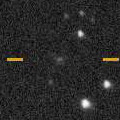
|
Now it is 17.4 mag (Jan. 3, Toshihiko Ikemura, Hirohisa Sato). It stays 16 mag for a long time from 2019 to 2020. It is observable in excellent condition in the Southern Hemisphere. It is hardly observable in the Northern Hemisphere.
Date(TT) R.A. (2000) Decl. Delta r Elong. m1 Best Time(A, h)
Apr. 27 12 20.79 -58 20.5 3.265 3.991 130 16.1 21:59 ( 0, 67)
May 4 12 4.02 -58 17.1 3.254 3.960 128 16.0 21:15 ( 0, 67)
|
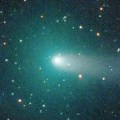
|
It brightened up to 9.5 mag from autumn to winter (Dec. 14, Marco Goiato). Now it is fading. It has already faded down to 14.9 mag (Apr. 21, Thomas Lehmann). In the Northern Hemisphere, it stays observable in good condition for a long time until it fades out. It locates low in the Southern Hemispehre.
Date(TT) R.A. (2000) Decl. Delta r Elong. m1 Best Time(A, h)
Apr. 27 9 24.83 36 46.9 2.248 2.545 95 16.4 19:06 (180, 18)
May 4 9 33.82 35 27.9 2.383 2.604 91 16.8 18:47 (180, 20)
|
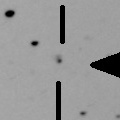
|
Asteroid, but it brightened rapidly. Now it is 17.3 mag (Nov. 14, Kunihiro Shima). It is observable in excellent condition in the Southern Hemisphere. It is hardly observable in the Northern Hemisphere.
Date(TT) R.A. (2000) Decl. Delta r Elong. m1 Best Time(A, h)
Apr. 27 22 28.30 -36 24.7 6.703 6.485 73 16.5 5:07 (286, 53)
May 4 22 27.63 -36 40.2 6.584 6.478 79 16.4 5:12 (284, 60)
|

|
It brightened up to 9.0 mag from autumn to winter (Nov. 16, Maik Meyer). Now it is fading. It has already faded down to 15.4 mag (Apr. 2, Toshihiko Ikemura, Hirohisa Sato). It is observable in excellent condition in the Northern Hemisphere. It stays low in the Southern Hemisphere.
Date(TT) R.A. (2000) Decl. Delta r Elong. m1 Best Time(A, h)
Apr. 27 7 2.46 21 31.5 2.550 2.371 68 16.5 18:47 (148, 26)
May 4 7 15.14 20 56.9 2.681 2.425 64 16.9 18:41 (146, 26)
|

|
Now it is 18.4 mag (Apr. 4, Toshihiko Ikemura, Hirohisa Sato). It will brighten rapidly after this. It will be observable at 13.5 mag in good condition in autumn.
Date(TT) R.A. (2000) Decl. Delta r Elong. m1 Best Time(A, h)
Apr. 27 17 49.38 -8 23.8 1.867 2.604 127 16.8 3:32 (180, 63)
May 4 17 50.75 -7 37.7 1.762 2.560 133 16.6 3:06 (180, 63)
|

|
Now it is 17.1 mag (Apr. 3, Toshihiko Ikemura, Hirohisa Sato). It stays 16-17 mag for a long time until 2020. It is observable in good condition in the Northern Hemisphere. It is not observable at all in the Southern Hemisphere.
Date(TT) R.A. (2000) Decl. Delta r Elong. m1 Best Time(A, h)
Apr. 27 10 48.08 70 57.9 8.419 8.453 88 16.8 20:28 (180,-16)
May 4 10 47.26 70 12.1 8.481 8.455 85 16.8 20:00 (180,-15)
|
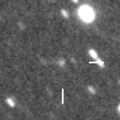
|
It will brighten up to 16.5 mag in June. It is observable in excellent condition in the Southern Hemisphere. It locates low in the Northern Hemisphere. It has not been observed since last October.
Date(TT) R.A. (2000) Decl. Delta r Elong. m1 Best Time(A, h)
Apr. 27 18 31.28 -32 23.4 3.235 3.827 119 16.9 4:14 (180, 87)
May 4 18 21.22 -33 53.3 3.106 3.807 127 16.8 3:37 (180, 89)
|

|
Now it is 17.3 mag (Apr. 1, Toshihiko Ikemura, Hirohisa Sato). It is observable at 17 mag in good condition in 2019. It locates somewhat low in the Northern Hemisphere.
Date(TT) R.A. (2000) Decl. Delta r Elong. m1 Best Time(A, h)
Apr. 27 15 46.76 -16 8.3 2.900 3.851 157 16.9 1:30 (180, 71)
May 4 15 42.54 -16 0.2 2.875 3.859 165 16.9 0:58 (180, 71)
|

|
Now it is 16.7 mag (Apr. 3, Toshihiko Ikemura, Hirohisa Sato). It is expected to be observable at 5-6 mag for a long time from 2022 to 2023. In the Northern Hemisphere, it is not observable at the highlight from 2022 summer to 2023 summer. In the Southern Hemisphere, it stays unobservable for a while. But it will be observable in good condition at the highlight.
Date(TT) R.A. (2000) Decl. Delta r Elong. m1 Best Time(A, h)
Apr. 27 18 8.82 57 17.5 11.673 11.795 94 17.1 3:51 (180, -2)
May 4 18 6.27 57 40.3 11.611 11.749 95 17.0 3:21 (180, -3)
|

|
Now it is 17.1 mag (Apr. 1, Toshihiko Ikemura, Hirohisa Sato). Fading slowly. It stays observable at 17 mag in good condition until summer.
Date(TT) R.A. (2000) Decl. Delta r Elong. m1 Best Time(A, h)
Apr. 27 11 27.93 10 32.7 9.406 10.106 131 17.4 21:08 (180, 45)
May 4 11 27.40 10 41.6 9.507 10.119 125 17.4 20:40 (180, 44)
|
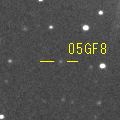
|
First return of a new periodic comet which brightened up to 16.5 mag in 2005. Now it is 17.8 mag (Apr. 1, Toshihiko Ikemura, Hirohisa Sato). It stays 17.5 mag until early summer.
Date(TT) R.A. (2000) Decl. Delta r Elong. m1 Best Time(A, h)
Apr. 27 12 57.01 -7 50.7 2.082 3.047 159 17.4 22:36 (180, 63)
May 4 12 53.86 -7 30.6 2.100 3.029 152 17.4 22:06 (180, 63)
|

|
Although it was faint as 16-17 mag in November, it brightened up to 14.7 mag in December (Dec. 12, Toshihiko Ikemura, Hirohisa Sato). Now it is fading. It has already faded down to 16.9 mag (Apr. 2, Toshihiko Ikemura, Hirohisa Sato). In the Northern Hemisphere, it stays observable in excellent condition after this. It stays extremely low in the Southern Hemisphere.
Date(TT) R.A. (2000) Decl. Delta r Elong. m1 Best Time(A, h)
Apr. 27 10 30.02 38 55.5 2.821 3.242 105 17.5 20:10 (180, 16)
May 4 10 31.76 37 50.1 2.934 3.272 100 17.7 19:44 (180, 17)
|

|
In the Southern Hemisphere, it is observable at 17.5 mag in good condition from spring to summer. In the Northern Hemisphere, it is not observable at all. It has not been observed since last September.
Date(TT) R.A. (2000) Decl. Delta r Elong. m1 Best Time(A, h)
Apr. 27 17 14.17 -56 13.6 3.729 4.390 125 17.8 2:58 ( 0, 69)
May 4 17 10.71 -56 40.6 3.668 4.389 130 17.7 2:27 ( 0, 68)
|

|
Now it is 17.7 mag (Apr. 6, Toshihiko Ikemura, Hirohisa Sato). It is expected to brighten up to 13.5 mag in 2021, and it will be observable in good condition in the Southern Hemisphere. In the Northern Hemisphere, it is not observable at the highlight.
Date(TT) R.A. (2000) Decl. Delta r Elong. m1 Best Time(A, h)
Apr. 27 13 58.99 8 28.1 6.520 7.460 157 17.8 23:38 (180, 47)
May 4 13 55.45 8 25.0 6.501 7.415 153 17.8 23:07 (180, 47)
|
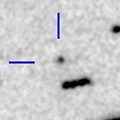
|
Now it is 18.3 mag (Apr. 1, Toshihiko Ikemura, Hirohisa Sato). It brightens up to 18 mag and it is observable in good condition from April to June. It locates somewhat low in the Southern Hemisphere.
Date(TT) R.A. (2000) Decl. Delta r Elong. m1 Best Time(A, h)
Apr. 27 14 3.40 29 56.5 1.852 2.673 136 17.9 23:42 (180, 25)
May 4 13 59.74 30 15.7 1.891 2.681 132 17.9 23:11 (180, 25)
|

|
Main-belt asteroid. But it shows a straight tail like a comet. Now it is 17.6 mag (Apr. 6, Toshihiko Ikemura, Hirohisa Sato). It stays observable in excellent condition until early summer.
Date(TT) R.A. (2000) Decl. Delta r Elong. m1 Best Time(A, h)
Apr. 27 10 3.10 6 32.4 1.631 2.240 114 17.9 19:43 (180, 48)
May 4 10 7.04 7 31.7 1.695 2.225 108 18.1 19:20 (180, 48)
|
|
![]()
 C/2018 F4 ( PanSTARRS )
C/2018 F4 ( PanSTARRS ) 38P/Stephan-Oterma
38P/Stephan-Oterma A/2017 U7
A/2017 U7 64P/Swift-Gehrels
64P/Swift-Gehrels 68P/Klemola
68P/Klemola C/2010 U3 ( Boattini )
C/2010 U3 ( Boattini ) C/2018 KJ3 ( Lemmon )
C/2018 KJ3 ( Lemmon ) 74P/Smirnova-Chernykh
74P/Smirnova-Chernykh C/2017 K2 ( PanSTARRS )
C/2017 K2 ( PanSTARRS ) C/2014 B1 ( Schwartz )
C/2014 B1 ( Schwartz ) P/2018 X1 ( LONEOS )
P/2018 X1 ( LONEOS ) 240P/NEAT
240P/NEAT 186P/Garradd
186P/Garradd C/2019 F1 ( ATLAS-Africano )
C/2019 F1 ( ATLAS-Africano ) 149P/Mueller 4
149P/Mueller 4 (6478) Gault
(6478) Gault![]()

































